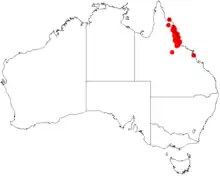| Brown salwood | |
|---|---|
| Scientific classification | |
| Kingdom: | Plantae |
| Clade: | Tracheophytes |
| Clade: | Angiosperms |
| Clade: | Eudicots |
| Clade: | Rosids |
| Order: | Fabales |
| Family: | Fabaceae |
| Subfamily: | Caesalpinioideae |
| Clade: | Mimosoid clade |
| Genus: | Acacia |
| Species: | A. celsa |
| Binomial name | |
| Acacia celsa | |
 | |
| Occurrence data from AVH | |
Acacia celsa, commonly known as brown salwood, is a tree belonging to the genus Acacia and the subgenus Juliflorae that is native to north eastern Australia.
Description
The tree typically grows to a height of 8 to 30 m (26 to 98 ft) with a single stem that has a trunk that has a diameter of around 80 cm (31 in). It has hard, thin and shallowly bark that is cracked and fissured along with flattened and acutely angled branchlets that are a light greenish colour at the extremities. Like most species of Acacia it has phyllodes rather than true leaves. The dark green to grey–green with a slight sheen, dimidiate phyllodes have a length of 5 to 15 cm (2.0 to 5.9 in) and a width of 1 to 3.5 mm (0.039 to 0.138 in) 5–15.5 cm long, (1–) 1.5–2.5 (–3.5) cm wide and thinly coriaceous with numerous longitudinal nerves numerous that are parallel and close together. It flowers between January and May producing yellow flowers.[1]
Distribution
It is endemic to north eastern parts of Queensland from as far north as Cooktown to the eastern area of the Atherton Tableland with a separate disjunct southern population located in the Paluma Range to the north west of Townsville. It is usually situated along coastal plains and on steep mountains often to around 600 to 900 m (2,000 to 3,000 ft) in height where it is a pioneer or canopy species as part of rainforest communities.[1]
See also
References
- 1 2 "Acacia celsa". WorldWideWattle. Western Australian Herbarium. Retrieved 27 September 2019.